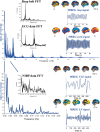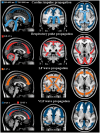Ultra-fast magnetic resonance encephalography of physiological brain activity - Glymphatic pulsation mechanisms?
- PMID: 26690495
- PMCID: PMC4908626
- DOI: 10.1177/0271678X15622047
Ultra-fast magnetic resonance encephalography of physiological brain activity - Glymphatic pulsation mechanisms?
Abstract
The theory on the glymphatic convection mechanism of cerebrospinal fluid holds that cardiac pulsations in part pump cerebrospinal fluid from the peri-arterial spaces through the extracellular tissue into the peri-venous spaces facilitated by aquaporin water channels. Since cardiac pulses cannot be the sole mechanism of glymphatic propulsion, we searched for additional cerebrospinal fluid pulsations in the human brain with ultra-fast magnetic resonance encephalography. We detected three types of physiological mechanisms affecting cerebral cerebrospinal fluid pulsations: cardiac, respiratory, and very low frequency pulsations. The cardiac pulsations induce a negative magnetic resonance encephalography signal change in peri-arterial regions that extends centrifugally and covers the brain in ≈1 Hz cycles. The respiratory ≈0.3 Hz pulsations are centripetal periodical pulses that occur dominantly in peri-venous areas. The third type of pulsation was very low frequency (VLF 0.001-0.023 Hz) and low frequency (LF 0.023-0.73 Hz) waves that both propagate with unique spatiotemporal patterns. Our findings using critically sampled magnetic resonance encephalography open a new view into cerebral fluid dynamics. Since glymphatic system failure may precede protein accumulations in diseases such as Alzheimer's dementia, this methodological advance offers a novel approach to image brain fluid dynamics that potentially can enable early detection and intervention in neurodegenerative diseases.
Keywords: Resting state; blood oxygen level dependent; cardiorespiratory; glymphatics; magnetic resonance encephalography.
© The Author(s) 2015.
Figures





References
-
- Rennels ML, Blaumanis OR, Grady PA. Rapid solute transport throughout the brain via paravascular fluid pathways. Adv Neurol 1990; 52: 431–439. - PubMed
Publication types
MeSH terms
Grants and funding
LinkOut - more resources
Full Text Sources
Other Literature Sources
Medical

